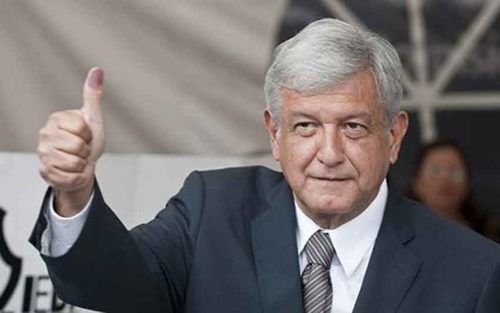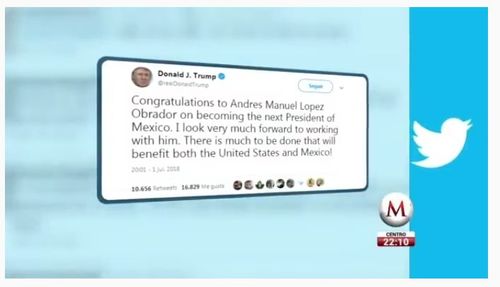
By Allan Wall
07/06/2018
For Andres Manuel Lopez Obrador, the third time was a charm. AMLO was elected Mexico’s new president on July 1 in what was hardly a nailbiter. By nighttime on election day, the outcome was clear.
Leftist AMLO has inspired no small amount of hysteria through the years, with some likening him to Hugo Chavez, the late neo-communist leader of Venezuela. Political guru Dick Morris popularized that view during the 2006 election, when the former Clinton Torpedo was advising AMLO’S opponent Felipe Calderon [Dick Morris Helping Mexican Candidate Surge?, by Carl Limbacher, NewsMax.com, May 2006]. With AMLO’s victory, Morris hasn’t changed his mind [Dick Morris: Watch Out As Hard Left Takes Over In Mexico, WesternJournal, July 2, 2018].
I don’t buy it. I don’t see AMLO as another Hugo Chavez. The new president’s politics are rooted firmly in the Mexican political tradition of the old Institutional Revolutionary Party, the PRI. The real danger is not that he’ll be another tinpot dictator, but that he’ll spend too much money and run up Mexico’s debt.
AMLO’s victory was impressive. Running as the standard-bearer of a three-party coalition headed by his National Regeneration Movement, or MORENA, which he founded, AMLO won 53.19 percent of the vote, according to the Mexican electoral commission.
In second place was a three-party coalition led by Ricardo Anaya of the National Action Party, the right-wing party so beloved of American conservatives. Anaya ran in coalition with the leftist Party of the Democratic Revolution, or PRD, AMLO’s old outfit! The biggest Trump-basher in the campaign, Anaya garnered 22.28% of the vote. The coalition led by the PRI got only 16.4%, while the independent candidate, Bronco, had 5.23%.
Mexico doesn’t have an electoral college, but if it did, AMLO would have won nearly all of it. The candidate had a majority in the federal district, Mexico City, and in 30 of 31 of Mexico’s states. Only in Guanajuato did AMLO lose. Such was AMLO’s vote tally that his opponents quickly conceded. AMLO had a convincing majority, although all that was necessary to win was more votes than the runner-up. And AMLO’s coalition appears to have a majority in Congress.

Why did AMLO win so big? People we knew, who always or almost always voted for the PAN (the middle-class party), voted for AMLO. They were looking for change. Kind of like the United States in 2008.
President Trump quickly tweeted congratulations, to which AMLO responded positively.
On July 2, AMLO and President Trump spoke by telephone for 30 minutes. Given that AMLO doesn’t speak English and Trump doesn’t speak Spanish, we may assume that means a 15-minute conversation with 15-minutes of translation. I wish I could be Trump’s Spanish translator! I volunteer if the current translator quits.
Here’s what they said about the conversation.
My translation of AMLO’s tweet:
I received a call from Donald Trump and we spoke for half an hour. I proposed to him to explore a comprehensive accord, of development projects that generate employment in Mexico, and thus will reduce migration and improve security. I was treated respectfully and our representatives will dialogue.
AMLO is speaking of “development projects that generate employment in Mexico, and thus will reduce migration.” That sounds very much like what he proposed during the campaign, an international development project, based on the Kennedy-era Alliance for Progress and presumably funded mostly by the United States, to promote development in Mexico and Central America.
AMLO has said his goal is that no one should have to migrate unless he wants to.
Superficially, it sounds like a good idea. The U.S. would help poor Latin Americans, who in turn would not emigrate — legally or not — to the United States. Somehow, I don’t think it would work that way. More likely, we’d pump big money into Latin America and the Latin Americans would keep coming.
Now let’s examine what Trump had to say about their chat, as reported in the Washington Examiner. [Trump Predicts Border Help From Mexico’s President-Elect After All, by Steven Nelson, July 2, 2018]
I suspect, by the way, that Trump and AMLO might get along. Trump said he had observed AMLO in a previous election and predicted he would win the presidency some day.
“I think the relationship will be a very good one,” Trump said. I hope he’s right.
Now, the details:
We talked about border security, we talked about trade, we talked about NAFTA. We talked about a separate deal, just Mexico and the United States.
That’s possible, but then Trump talked about immigration:
I think he’s going to try to help us with the border.
I seriously doubt it.
Nothing against AMLO, but I cannot imagine any Mexican government, of any Mexican political party or coalition, supporting us in controlling the border. Is a Mexican government going to tell its people: “You can’t enter the United States illegally”? Will the Mexican government stop people from crossing the border illegally?
During the campaign, AMLO actually said that everyone in the world has the right to enter the United States.
Trump also said this:
We have unbelievably bad border laws, immigration laws — the weakest in the world, laughed at by everybody in the world. And Mexico has very strong immigration laws, so they can help us until we straighten out our immigration laws.
I don’t know what Trump is thinking. How on Earth will Mexico help us “straighten out our immigration laws”?
As I have observed before, we could learn a lot from Mexican immigration law, which is designed to further the interests of Mexico. Why would Mexican leaders help us rewrite our immigration law to further our interests?
They wouldn’t. Mexican diplomats routinely meddle in our legal system to defend Mexican illegal aliens. They did that under a PRI government, they did that under a PAN government, and they’ll do it under an AMLO government.
As for Mexico’s immigration law relating to illegal aliens crossing through Mexico, many Central American illegal aliens are being detained and deported by Mexico. But obviously, a whole lot are getting through, and some — such as the illegals in the recent caravan — actually have received permits to cross Mexico to get to the United States. If Mexico has such strong immigration laws, why is this allowed?
Will President AMLO, who Trump says is going to “help us with the border,” seal Mexico’s southern border?
Not according to what he said in the second Mexican presidential debate: “The neighbors of the north…want us to continue doing the dirty work to stop Central Americans.” Stopping Central Americans is not, AMLO said, what Mexico should do. And, again, Mexico helped the caravan. That suggests he wants free passage for all U.S.-bound Central Americans.
Maybe AMLO has changed his mind. Maybe what he said about migration was all campaign rhetoric. Maybe he’s ready to “help Trump with the border.”
But I doubt it. Trump needs to be aware of what AMLO said during the campaign. If he wants to help us, he has to prove it. I just don’t believe he, or any Mexican leader, would do it.
I wish I could be Trump’s personal adviser on Latin America and immigration. I would love to sit down explain these things to him.
I support good relations with Mexico. I support any mutually beneficial cooperation between the United States and Mexico.
But immigration is our responsibility, not Mexico’s, and we’ve got to get control of it.
A side note on Mexico’s election laws:
I wrote this piece from Mexico. We’re here because my wife, a legal U.S. resident, is a Mexican citizen. She voted here.
I accompanied her to vote, but I’m not a Russian, so I made sure not to meddle! I only observed.
Anyway, I’ve written before about Mexico’s admirable voter ID system. We should adopt something similar nationwide.
Each Mexican voter has a government-issued photographic voter ID card, which he presents to election authorities. They have a book with the photograph of each and every voter precinct. Each precinct has such a book.
Across from the election authorities are seated representatives from various political parties. When the election authority at the table calls the name of the voter, his name is checked off in the precinct book. The voter also has his thumb stained with ink that wears off in a few days.
It’s a great system, but whenever photo ID is suggested in the United States, liberals get hysterical. They say requiring photo ID is racist because it will disenfranchise minority voters.
Only seven American states, according to the National Conference of State Legislatures, require photo ID: Georgia, Indiana, Kansas, Mississippi, Tennessee, Virginia, and Wisconsin [Voter Identification Requirements / Voter ID Laws, NCSL, May 15, 2018].
The rest of the states fall into four other categories: “strict non-photo ID, “photo ID requested,” “ID requested, photo not required,” or — get this — “no document required to vote” [emphasis added]. That last category includes 17 states, almost all of them blue.
Maybe all these Mexican immigrants can teach us something about secure voting procedures!
American citizen Allan Wall (email him) moved back to the U.S.A. in 2008after many years residing in Mexico. Allan’s wife is Mexican, and their two sons are bilingual. In 2005, Allan served a tour of duty in Iraq with the Texas Army National Guard. His VDARE.COM articles are archived here; his Mexidata.info articles are archived here; his News With Views columns are archived here; and his website is here.
This is a content archive of VDARE.com, which Letitia James forced off of the Internet using lawfare.